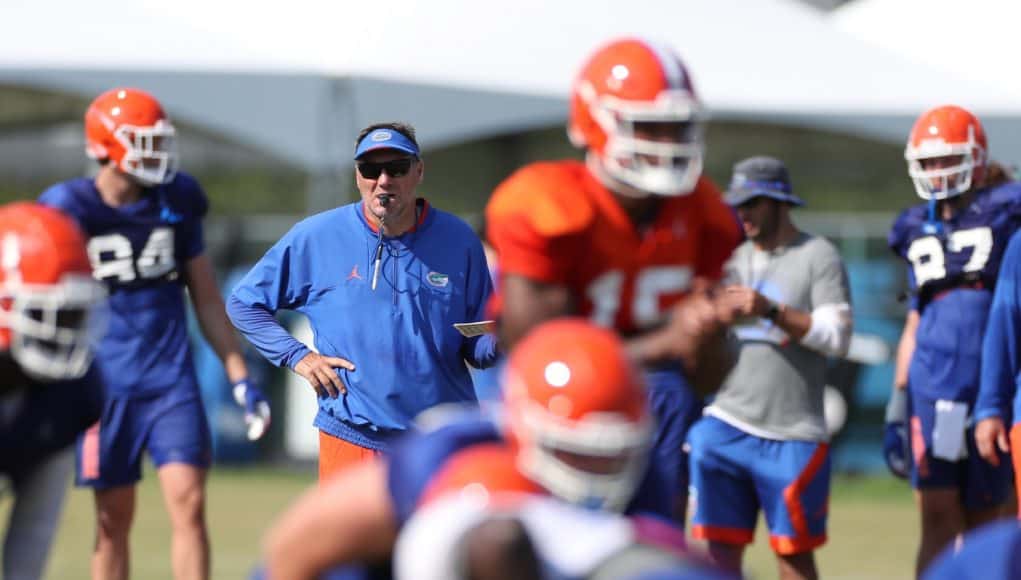There’s a popular saying among football coaches and analysts that if you have two quarterbacks, you have none.
There is some merit to that theory. The quarterback is looked to as the undisputed leader of the entire team. When things go poorly, everybody else on the team looks to him for leadership and direction. If you rotate quarterbacks, you often don’t have that one undisputed leader.
From a physical standpoint, why would you take out one quarterback if the offense is clicking just fine with him at the helm?
Then there’s Dan Mullen. The fourth-year Florida head coach has become famous in part for his ability to seamlessly mesh two quarterbacks into his game plans. There was Chris Leak and Tim Tebow in 2006, Feleipe Franks and Emory Jones in 2018 and Kyle Trask and Jones in 2019-20. He also played multiple quarterbacks on occasion during his tenure as Mississippi State’s head coach.
He plans to do the same thing this season with Jones and Anthony Richardson.
Unlike other coaches, he doesn’t play two quarterbacks because he’s not getting the production he’s looking for out of his starter. Instead, he makes an intentional effort to get multiple quarterbacks into games.
There are two primary reasons for Mullen’s preference to play two guys. First, there’s the strategic element to it. In 2006, Leak was a classic pocket-passer with a strong arm but limited mobility. Tebow was a bulldozer who was still in the developmental stages as a passer. Mullen implemented a similar rotation the past two seasons, with Trask as the passer and Jones as the runner.
In those situations, playing two quarterbacks with vastly different skillsets allowed him to fully open up his playbook and make defensive coordinators’ heads spin while trying to prepare for all of the possibilities.
“Every situation is very different and unique,” Mullen said. “Obviously, you look at a situation, if your quarterbacks have very different skillsets, there’s a value in using different ones on the field.”
But what about this year? Jones and Richardson are similar players, with the only major differences being Richardson’s size and physicality.
Mullen still plans to play Richardson because he believes getting him involved will aid in his development and prepare him to become the starter at the drop of a hat (or a headset, as it were), should that become necessary.
“We don’t have preseason games,” Mullen said. “We don’t have that, so guys are one snap away from being the guy, and we put a lot on our quarterback. We’re a very quarterback-based offense. So, if you sit there and look at somebody and say, ‘Hey, I know you’ve never stepped foot on the field before, but, in the fourth quarter of the game, we expect you to go win the game for us,’ that’s a hard situation to put people into. But if they’ve been on the field, if they’ve had experience, if they’ve played, then it is a little bit easier for that situation to put them into.”
If you need evidence that this approach works, just look at Jones. He played a few snaps here and there against teams like Georgia, Michigan, Auburn, LSU, Florida State and Alabama over the past three seasons.
Now that he’s set to be the starter, Jones feels confident in himself, and his teammates and coaches are able to trust him.
“There were times that we would put him in for one to two plays and he would do well, and we just leave him on the field,” Mullen said. “I feel bad; maybe it hurt Trask’s statistics sometimes last year. But, if Emory went in and we put him in to run a play or maybe two plays and, all of a sudden, we hit those two plays, we just leave him out there and just keep calling the offense. So, I think he’s pretty comfortable with it.
“I think he’s ready for that moment, to be out there on the field and go make plays, and he knows that we’ve put him out there to run specific plays, but there’s times we’ve just left him out there to keep running the plays. So, that’s why I think he’s going to be comfortable with what we have going on.”
Now Mullen will try to help Richardson follow a similar progression.


